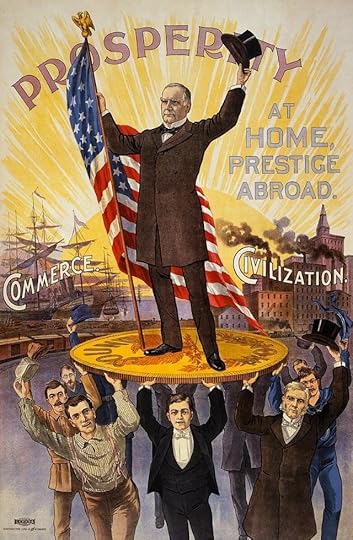What Trump can Learn from McKinley’s Tariffs
 By Quentin R. Skrabec Jr.
By Quentin R. Skrabec Jr.If Trump is to be successful as regards tariffs, he must look at President William McKinley’s successes and mistakes.
As a young, struggling congressman, William McKinley’s friend President Rutherford Hayes told him to specialize and develop expertise in tariff policy. McKinley’s first legislative effort as a congressman was to increase tariffs in 1877. McKinley rose quickly to chair of the Ways and Means Committee. McKinley was instrumental in forming a Tariff Commission and became a framer of the 1882 Tariff Bill.
His chairmanship led to the passage of the famous “McKinley” Tariff Act of 1890. The Tariff of 1890 went too far and lacked the appropriate guardrails to address inflation and potential trade wars. The 1890 Tariff roughly added a 50% tariff on all manufacturing imports. McKinley’s colleagues overruled him, following the model of tariffs as revenue producers versus McKinley’s model of protectionism for American industry. The short-term adverse effects and political impact cost McKinley and many other Republicans their seats two years later.
McKinley’s return to Congress in 1896 would be the forge for America’s first voting alliance of workingmen and manufacturing capitalists, which won him the White House twice.
The era of McKinley tariff protection lasted from 1880 to 1920. In 1880, the American steel industry struggled to expand against British steel’s supremacy but flourished under the McKinley tariffs. Steel production went from 1.3 million tons in 1880 to 11.2 million tons in 1900 to 28.3 million tons in 1910. In 1898, the American steel industry surpassed Britain in pig iron production. The U.S. gross national product grew from an estimated $11 billion in 1880 to $18.7 billion in 1890 to $35.3 billion in 1910.
The American glass industry was another struggling industry in 1880 due to imports. By 1910, the McKinley tariffs reversed the trend, and the glass industry had increased its output five to tenfold. During the peak tariff years of 1896 to 1901 under President McKinley, steel production increased 111%, electrical equipment production increased 271%, and farm equipment increased 149%. During the same period, wages increased by 10% and employment by 20%. Even more impressive to free traders, prices fell as productivity and innovation mushroomed. Macro and microeconomic data of the period continue to be debated, but McKinley won the working-class dinner table.
An example of McKinley’s short-term failure and long-term success was tinplate. England had destroyed American tinplate production and controlled the market at the time. Tinplate household items and canned products were essential to American farmers and the frontier.
In the short run, the McKinley tariffs did increase the price of tinplate with the 1890 Tariff Act. The Republicans lost Congress and the presidency in a landslide in 1892, with McKinley losing his seat. The goal, of course, in the long run, was to develop the American infant industries such as tinplate. The high price spurred exploration for tin and increased American investment in tinplate and canning. Before 1890, there were a handful of tinplate manufacturers in the United States, but by 1893, 200 mills produced 13,000,000 pounds of tinplate. The cost of tinplate dropped dramatically by 1895 as the McKinley tariffs created a competitive domestic tinplate industry, putting profits back into the business. It was a harsh lesson of the market and domestic production lagging.
[…]
Via https://www.americanthinker.com/articles/2025/02/what_trump_can_learn_from_mckinley_s_tariffs.html
The Most Revolutionary Act
- Stuart Jeanne Bramhall's profile
- 11 followers



